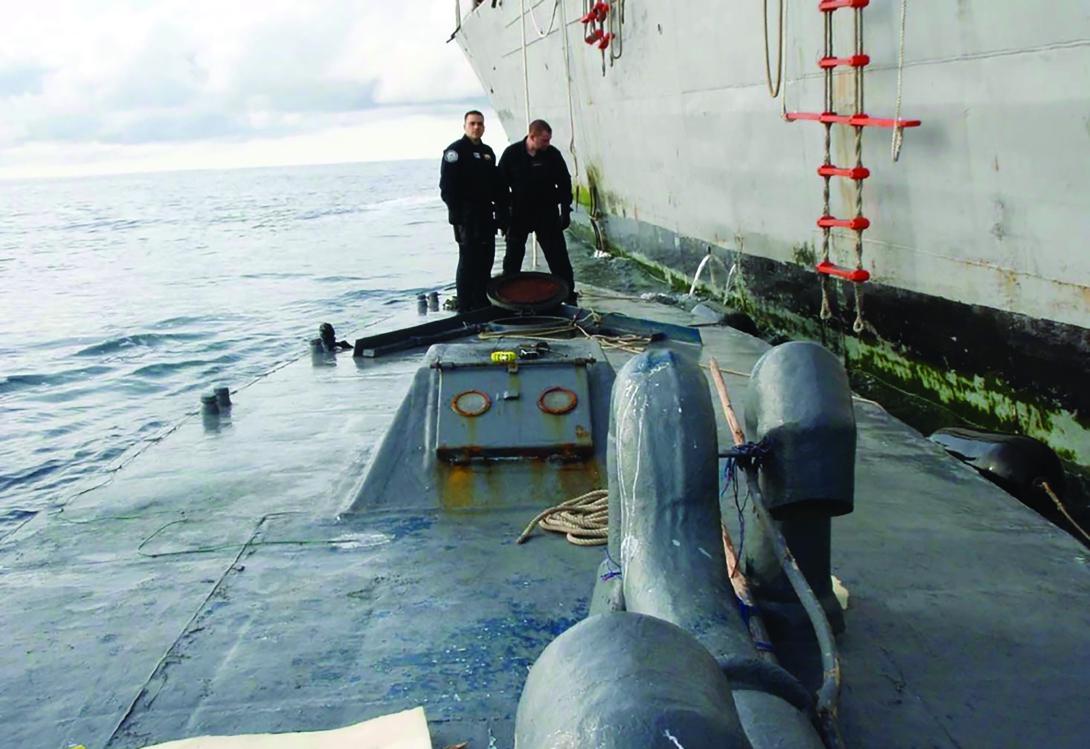Narco-Subs: A Game of Hide-and-Seek
Drug traffickers expand the use of submersible vessels to transport illicit substances as states struggle to detect them. This whack-a-mole game sees cartels improve the seaworthiness and technologies employed in building these boats.
“There’s an increasing and intensive use of these devices, as the quality improves with time,” said Mariano Bartolomé, transnational crime lecturer at the Inter-American Defense College in Washington, D.C., a school linked with the Organization of American States.
“They started with boats with a wooden structure covered with cloth, like kayaks, and later that cloth was replaced by some type of glass fiber on top, but definitely these were very simple devices; and now, they replace diesel engines for batteries, or they even have both systems,” Bartolomé explained.
The 1990s and early 2000s saw these vessels evolve until the Colombian navy intercepted a submarine in what is now considered a pivotal moment in these operations.
“In 2006, they interdicted the first drug submarine, and the Colombians were good enough to allow us to bring it up to Key West,” said Rear Adm. Mark Fedor, director, Joint Interagency Task Force South at the U.S. Coast Guard.
Cocaine smuggling showed signs of sharp growth after the pandemic. Cocaine seizures by the United States went from 150 tons in 2020 to an estimated 250 tons in 2021, according to the latest figures from the United Nations Office on Drugs and Crime (UNDOC). Other illicit substances are seeing increased interdictions as well.
Coca cultivation, the raw material for producing the alkaloid, has tripled between 2014 and 2021, while cocaine production doubled from 900 tons in 2014, according to the UNDOC. Sea transport dominates logistics, and authorities estimate that the illicit cargo is usually hidden in containers.
All interviewed sources estimated that a small portion of trafficking (less than 10%) travels on semisubmersibles. Nevertheless, the logistics network may be only the tip of the iceberg.
“This kind of vehicles draw their success from their support at sea. We know that there are fishing ships that support them with water, fuel, to continue their journey to the north on the Pacific, to the north on the Caribbean or to the west on the Atlantic,” said Adm. Francisco Cubides, Colombia National Navy commander.
The vehicles now have global positioning systems and communications equipment to successfully cross the Atlantic Ocean, resupply in the sea and arrive at the exact point in Europe where the cargo must be delivered.
Electric propulsion poses technical challenges that are being overcome as law enforcement catches up with boat-operating criminals.
But this is only a small part of the whole picture. Transnational criminal organizations are also building and operating drones that cover shorter distances with illicit cargo.
These unmanned vehicles “can be controlled remotely, with, for instance, a tablet, and these vessels have a 30-to-50-kilometer autonomy. With that, they can cross from the African coast to the coast of Spain,” Bartolomé said. “All the space is distributed between the load, engines and fuel.”
The UNDOC has so far identified two types of water drones. One is fully submersible and the other is a surface vessel. Submersibles can transport 100 to 200 kilograms (up to 440 pounds), while surface vessels could carry more than 320 kilograms (about 705.48 pounds).
Larger manned vessels have been known to carry up to 8 tons of cocaine, a load that could fetch well over 1 billion dollars in the streets of large European cities, according to figures compiled by European Monitoring Centre for Drugs and Drug Addiction.
While it is impossible to calculate the total value of the cargo aboard any freighter, when the MOL Comfort sank in 2013 along with its 4,328 containers, the cost to insurers was estimated at up to $400 million by The Maritime Executive, a trade publication.
One single run by a cartel-owned manned submersible could be worth more than a medium-sized container vessel crossing the ocean, including the cargo and the ship itself.
The average cost to the drug smugglers for one of these boats is just below a million dollars, according to Colombian navy estimates.
“An organization sends the vessel with the illicit cargo, and they discard it,” said Rear Adm. Norman Iván Cabrera Martínez, Colombian chief of naval intelligence. This means that manned sea traffic is one way only.
With the Drug Trafficking Vessel Interdiction Act of 2008, the U.S. Congress declared that operating or embarking on a submersible vessel of any kind posed serious threats to national security.
The U.S. Coast Guard (USCG) champions the effort of detecting and monitoring narcotics headed toward U.S. soil. “With 15 different interagency partners from law enforcement to the intel community, and then 20 different countries are represented here with foreign liaison officers.” Adm. Fedor explained the tactics of Joint Interagency Task Force South. “We bring all that together … we can leverage all sorts of information to figure out where people are.”


In addition to maritime patrol aircraft, Fedor referred to unmanned aerial capabilities available aboard USCG ships. Still, a lack of assets remains a challenge in combating drug smugglers.
With fleets being pulled in multiple directions, readiness remains an ongoing issue. And as fleets get older, the number of assets declines.
“So, the Coast Guard and the Navy are our primary service force providers, and you know they both have lots of demand on them.” Adm. Fedor stressed the relevance of adding new assets to this fight as traffickers adapt more civilian technologies to improve their activities.
Each year, the Coast Guard receives around 10,000 pieces of information, which could lead to drug smuggling cases, according to Adm. Fedor. “Overall, we kind of bring that down to about 3,500 cases,” he continued. Due to low resources, the USCG can only interdict around 10% of those cases with the help of partner nations.
Still, Fedor assures that ruthless efficiency and staying on target ensure success, even in this needle-in-a-haystack operation.
The fight against seaborne trafficking is an existential concern for many Latin American states, and the United States acts as a partner that brings stability. Counterintuitively, this is another angle of the fight against China’s influence in the Americas.
“China and the Russians are here now in the Western Hemisphere and use those gaps and seams to create more influence,” Adm. Fedor said.
The smaller the space for disruption and lawlessness, the less room for adversarial state actors and their proxies to roam.
“It’s really helping to stabilize this region, and it’s our partner nations when we talk to them. Their number one security concern is transnational criminal organizations. They know about China and Russia, but this is their number one concern,” Adm. Fedor told SIGNAL Media.
While final objectives may not be completely aligned between the United States and its regional partners, U.S. Coast Guard intervention, together with U.S. intelligence, military institutions and other law enforcement agencies, serves the core goals of the nation. “It’s much bigger national security goals we’re pursuing through that counternarcotics mission,” Adm. Fedor said.
Drug Trafficking Under Water
Colombia and the United States have drafted laws that penalize the sole possession and operation of a submersible.
“Colombia has an anti-semisubmersible law,” said Rear Adm. Norman Iván Cabrera Martínez, Colombian chief of naval intelligence.
“Before, when we went to interdict them, crews would sink them and our operation would turn into search and rescue,” Adm. Martínez said.
“We would end up rescuing drug traffickers as if they were castaways,” said Adm. Francisco Cubides, Colombia National Navy commander.
A 2009 law added articles in the Colombian penal code that punishes with six to 12 years in prison those who “build, sell and/or have semisubmersibles or submersibles. Unauthorized financing, construction, stores, sells, transports, buys or uses a semisubmersible or a submersible,” the law specified.
If these vehicles are involved in drug trafficking, sentences can be increased to a maximum of 14 years and fines.
Colombian authorities must only prove that suspects possessed or operated a suspicious vessel for a conviction.
The previous year the United States passed the Drug Trafficking Vessel Interdiction Act of 2008. This regulation establishes a maximum prison time of 15 years and fines.
“Essentially, what it said was, unless you are operating a submarine under flag state authority, operating one of these vessels at sea is illegal,” said Rear Adm. Mark Fedor, director, Joint Interagency Task Force South at the U.S. Coast Guard.
“We’re going to consider it illegal because the concern is not only could they smuggle narcotics, and it’s upwards of 3 to 4,000 kilograms of cocaine at once on one of these vessels, there’s no reason to think it couldn’t smuggle something else, like [weapons of mass destruction] or a chemical, biological, radiological weapon,” Adm. Fedor added.
Disrupting Delivery
Though cannabis continues to be legalized by North and South American nations, the U.S. Coast Guard has seen an unexpected rise in bulk marijuana shipments for the first time since the ’80s.
“In [fiscal year] 2017, we disrupted about 26,000 pounds of marijuana,” U.S. Coast Guard’s Adm. Mark Fedor explained. “Last year, we disrupted 140,000 pounds (about 64,000 kg) of marijuana, and we’re currently on track to probably break that number this year.”
According to U.S. Customs and Border Protection figures, Air and Marine Operations seized 573,270 pounds of marijuana in 2021, with a drop to 79,874 pounds in 2022.
Comparably, European countries reported seizure of 290,685 kgs (about 640,000 pounds) of marijuana in total in 2020, according to the European Monitoring Centre for Drugs and Drug Addiction. Europe saw that figure drop from 451,000 kgs (about 994,283.62 pounds) in 2017.
As Europe and the United States seize less overall, marine marijuana interdictions have grown significantly.
Adm. Fedor stressed that the marijuana the U.S. Coast Guard finds at sea has higher concentrations of its active component—THC, or tetrahydrocannabinol—than the legal varieties in the United States. The rise in genetically modified marijuana distribution could be spurred by its higher THC content, Adm. Fedor evaluated. Traffickers adapted their business to new market conditions with novel products.
This is, however, a cautionary tale that cartels may be taking advantage of regulation through legalization and marine trafficking toward the United States as a preferred medium of transport.





Comments